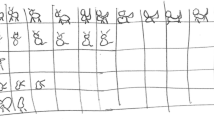Abstract
The goal of this paper is to demonstrate the infrastructural nature of many modern conceptual technologies. The focus of this paper is on conceptual tools associated with elementary types of data modeling. We intend to show a variety of ways in which these conceptual tools not only express thinking, but also mold and shape thinking. And those ways of thinking are often out of sync with the situations that we need to understand and explain. We have chosen to discuss data modeling because in mathematics education, future-oriented statements of curriculum standards generally identify data modeling as a topic that should receive priority attention. Several example activities based on the models and modeling perspectives (MMP) are used to support the claims that: (a) statistical techniques are based on models, (b) alternative models often make significantly different assumptions about how to measure even elementary things such as distances and spread. Also, new technologies for computation, conceptualization, and communication are making significant changes in which statistical techniques are easily executed. Moreover, these newly available techniques are often based on assumptions that are more realistic given the relevant quantities and relationships.






















Similar content being viewed by others
Notes
Unfortunately, completely different lines may satisfy these two conditions. For example, consider three points in a plane. The line that satisfies condition 1 will go through two of the three given points; but, the point that satisfies condition 2 will only go through one of the points.
Even in cases where solutions could be found for least distance curves, the solutions often were not unique—or else there did not exist function-based ways to describe errors.
For the graphs in the fourth row of Fig. 20, we graphed the average rather than the sum because we wanted to avoid having the resulting graph go outside the window of the graph.
References
David, H. A. (1999). A 1-credit course on the history of statistics. Proceedings of the section on statistical education (pp. 245–248). Alexandria, VA: American Statistical Association.
de Laubenfels, R. (2006). The victory of least squares and orthogonality in statistics. The American Statistician, 60(4), 315–321.
Gleick, J. (1987). Chaos: Making a new science. New York: Vintage.
Hald, A. (1998). A history of mathematical statistics from 1750 to 1930. New York: Wiley.
Holland, J. (1998). Emergence: From chaos to order. Redwood City, California: Addison-Wesley.
Kauffman, S. (1993). The origins of order : Self-organization and selection in evolution. Oxford, England: Oxford University Press.
Lesh, R. & Harel, G., (2003). Problem solving, modeling & local conceptual development. In R. Lesh (Ed.), Models & modeling in mathematics education. Monograph for International Journal for Mathematical Thinking & Learning. (pp. 78–99). Hillsdale, NJ: Lawrence Erlbaum Associates.
Seal, H. L. (1970). Studies in the History of Probability and Statistics. XV. The historical development of the Gauss linear model. Biometrika 54, 1–24. Reprinted (1970) In E. S. Pearson, & M. G. Kendall (Eds.), Studies in the history of statistics and probability. London: Griffin.
Stigler, S. M. (1986). The history of statistics: The measurement of uncertainty before 1900. Harvard University Press: Cambridge.
Stigler, S. M. (1999). Statistics on the table: The history of statistical concepts and methods. Harvard University Press: Cambridge.
Author information
Authors and Affiliations
Corresponding author
Rights and permissions
About this article
Cite this article
Lesh, R., Caylor, E. & Gupta, S. Data Modeling & the Infrastructural Nature of Conceptual Tools. Int J Comput Math Learning 12, 231–254 (2007). https://doi.org/10.1007/s10758-007-9124-0
Received:
Accepted:
Published:
Issue Date:
DOI: https://doi.org/10.1007/s10758-007-9124-0




